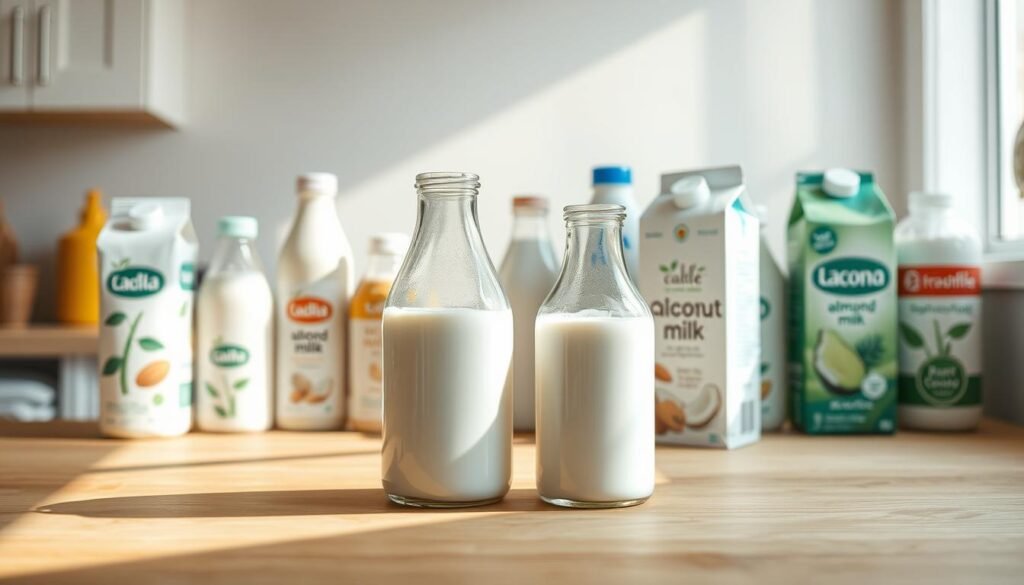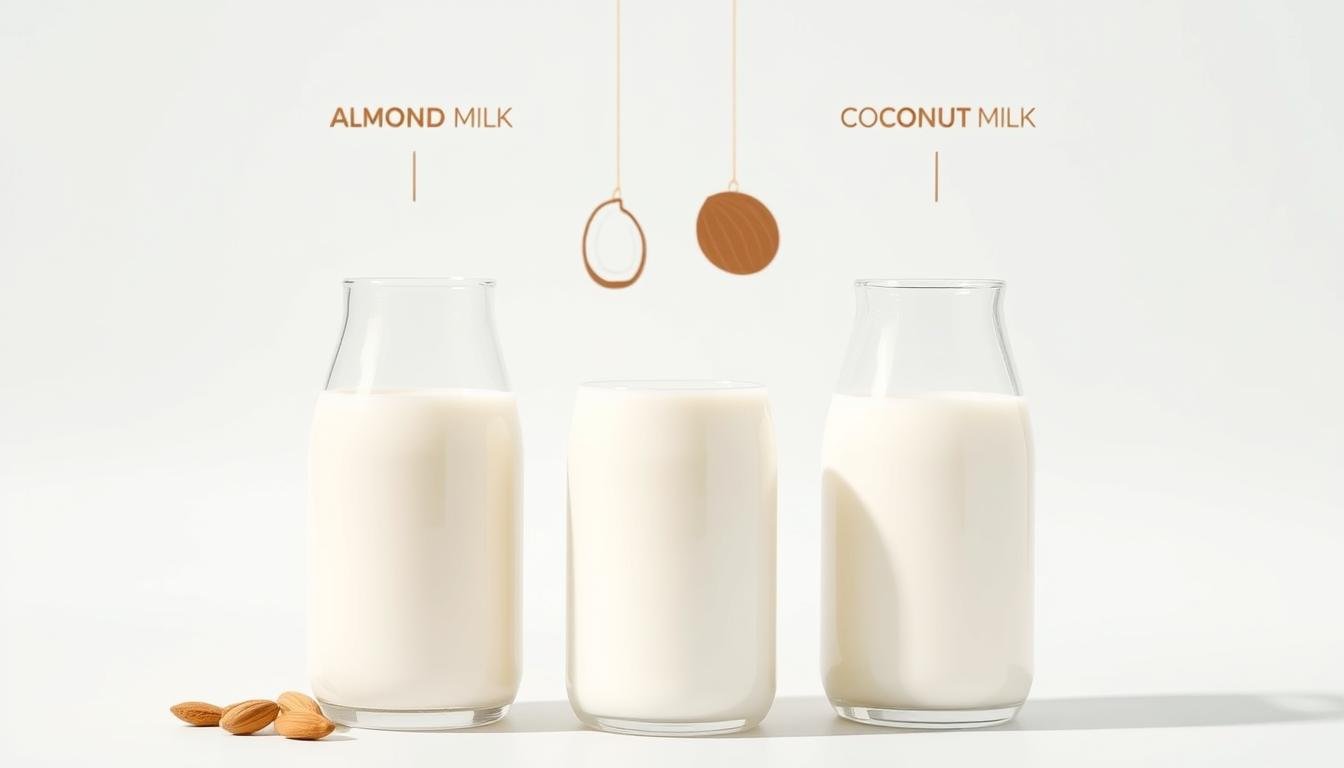Is your favorite plant-based milk secretly undermining your health goals? With over 42% of American households now choosing dairy alternatives, the almond vs. coconut milk debate has never been more relevant. Let’s cut through the noise and explore what really matters for your wellness journey.
Recent Instacart data reveals a fascinating split: almond milk dominates nationwide, while coconut milk claims top spot in the Pacific Northwest. But popularity doesn’t equal nutritional value. Did you know coconut milk contains 5x more saturated fat than its almond counterpart? Or that almond varieties often lack crucial vitamin B12 fortification?
Our analysis goes beyond basic calorie counts. We’ll break down:
- Essential vitamin fortification trends
- Environmental impact comparisons
- Culinary performance in different recipes
Whether you’re managing heart health or seeking bone-strengthening options, understanding these detailed nutritional profiles becomes crucial. Let’s find which plant-powered option truly deserves space in your fridge.
Key Takeaways
- Plant-based milk consumption grew 27% since 2020
- Almond milk averages 60% fewer calories per serving
- Coconut varieties contain 100% saturated fat content
- Fortification levels vary significantly between brands
- Both options reduce carbon footprint vs dairy
Introduction: Exploring Almond Milk and Coconut Milk
As dairy aisles evolve, plant-based options are rewriting the rules of nutrition. Made from soaked nuts or coconut flesh, these alternatives now account for 15% of all milk sales nationwide. The International Food Information Council (IFIC) reports 68% of consumers cite lactose intolerance as their primary reason for switching – but taste and sustainability also play key roles.

Traditional cow’s milk still dominates protein content, but many find nut and fruit-based versions easier to digest. A 2022 IFIC survey found:
- 43% choose alternatives for environmental reasons
- 29% prefer the flavor profiles
- 22% seek lower calorie counts
This shift reflects growing awareness about food choices impacting personal wellness and planetary health. While animal-derived options provide natural calcium, fortified plant drinks often match or exceed these levels. Let’s examine how popular varieties stack up nutritionally:
| Calories (per cup) | Protein (g) | Saturated Fat (g) | Water Usage (L per liter) | |
|---|---|---|---|---|
| Whole Cow Milk | 149 | 7.7 | 4.6 | 628 |
| Unsweetened Almond | 37 | 1.5 | 0 | 371 |
| Canned Coconut | 445 | 4.5 | 43 | 270 |
Upcoming sections will explore how processing methods affect nutrient retention and why chefs increasingly favor specific varieties for baking versus sauces. Whether you’re vegan or simply curious, understanding these differences helps make informed dietary decisions.
which is healthier almond or coconut milk: Nutritional Comparison

Navigating grocery store shelves reveals stark nutritional contrasts between popular dairy alternatives. Let’s unpack what each sip delivers.
Energy and Macronutrient Profiles
Unsweetened varieties show dramatic differences. A cup of almond drink contains just 37 calories versus coconut’s 45 calories. But numbers tell only part of the story.
| Nutrient | Almond (per cup) | Coconut (per cup) |
|---|---|---|
| Calories | 37 | 45 |
| Saturated Fat | 0g | 4.5g |
| Protein | 1.5g | 0.5g |
| Added Sugars | 0g | 0g |
Coconut options pack 100% saturated fat content – nearly matching whole dairy milk. The American Heart Association recommends limiting this fat type to protect cardiovascular health.
Micronutrient Boosters
Fortification bridges nutritional gaps. Many almond versions provide 50% more calcium than cow’s milk through enrichment. Coconut varieties naturally offer manganese and iron but often lack added vitamin D.
Key differences emerge in daily value percentages:
- Vitamin E: Almond 50% vs Coconut 4%
- Calcium: Both often match dairy at 30% DV
- B12: Only fortified options contain this
For those monitoring fat intake, almond-based choices typically align better with heart-healthy guidelines. However, coconut’s creaminess makes it ideal for specific culinary applications where texture matters most.
Production and Ingredients: How Almond and Coconut Milk Are Made
Ever wondered how your creamy dairy alternative transforms from raw ingredients to fridge staple? The journey from nut or coconut to beverage involves distinct methods that shape flavor, texture, and nutritional value.

Almond Milk Processing Techniques
Creating almond-based drinks starts with soaking raw nuts overnight. Manufacturers then blend them with water and strain the mixture through fine filters. This removes pulp, leaving a smooth liquid. Many brands add thickeners like carrageenan for texture and fortify with calcium to match cow’s milk levels.
Store-bought versions often contain just 2-5% almonds. Key additives include:
- Gellan gum for stability
- Vitamin D for bone health
- Natural flavors to enhance taste
Coconut Milk Production Methods
Coconut varieties begin with grated white flesh. Producers press it to extract rich cream, then dilute it for carton versions. Canned options use minimal water, retaining higher fat content. Unlike almond alternatives, coconut drinks naturally provide manganese but lack protein.
Watch for added sugars in flavored options. Carton varieties often include:
- Guar gum for thickness
- B12 for vegan diets
- Phosphates as preservatives
Both alternatives undergo pasteurization for safety, but homemade versions skip additives. Understanding these processes helps choose options aligning with dietary needs and taste preferences.
Health Benefits and Risks of Plant-Based Milks
Plant-based milks promise wellness, but their nutritional realities might surprise you. While these alternatives offer unique advantages, their effects vary dramatically depending on individual health needs and consumption patterns.
Heart Health and Fat Content
Coconut-based drinks contain medium-chain triglycerides (MCTs) that may boost metabolism. However, their saturated fat content raises concerns – a single cup delivers 43% of the American Heart Association’s daily limit (13g for most adults).
Almond options shine with zero saturated fat and high vitamin E levels. Studies suggest this antioxidant may reduce bad cholesterol by up to 6.5% when consumed regularly. But balance matters:
- Pros: Coconut’s MCTs support brain function
- Cons: Excessive intake links to cardiovascular risks
Allergy and Growth Concerns
Tree nut allergies affect 1.8% of Americans, making almond drinks risky for some. Coconut allergies are rarer but still present. Pediatricians often caution against relying solely on plant-based options for children under five due to:
- Low protein in almond varieties (1.5g vs dairy’s 8g)
- Insufficient calories for growth needs
Fortified versions help bridge nutritional gaps. Always check labels for calcium and vitamin D levels – crucial for bone development in all age groups.
Culinary Uses and Flavor Profiles of Almond and Coconut Milk
Ready to transform ordinary recipes into dairy-free delights? The right liquid base can elevate flavors while keeping dishes allergen-friendly. Let’s explore how these popular options perform in the kitchen.
Cooking Applications in Savory and Sweet Recipes
Coconut-based varieties bring tropical richness to meals. Their higher fat content creates velvety textures perfect for:
- Thai green curry with eggplant
- Creamy butternut squash soup
- Dairy-free ice cream bases
Nut-based options shine in lighter preparations. Their subtle profile blends seamlessly into:
- Blueberry oatmeal muffins
- Vanilla chia pudding
- Herbed salad dressings
| Application | Coconut Uses | Almond Uses |
|---|---|---|
| Soups | Adds creaminess | Light broth base |
| Baking | Moist cakes | Fluffy pancakes |
| Sauces | Rich gravies | Herb-infused dips |
Ideal Uses in Beverages and Smoothies
For coffee lovers, nut-based versions froth better than coconut options. Barista blends withstand steaming without separating. Try these combos:
- Iced matcha latte with vanilla-flavored almond base
- Turmeric golden milk using light coconut carton milk
In smoothies, coconut’s natural sweetness pairs with mango and pineapple. Nut varieties complement peanut butter or cocoa powder beautifully. Pro tip: Freeze leftover liquids into ice cubes for thicker blended drinks!
Environmental Impact and Sustainability Considerations
The environmental footprint of our food choices often goes unnoticed behind glossy packaging. Plant-based beverages carry hidden ecological costs tied to farming practices and resource management.
Water Usage and Resource Efficiency
Growing nuts for dairy alternatives demands significant resources. Almond crops require 371 liters of water to produce one liter of milk – nearly double coconut farming’s 270-liter footprint. This disparity stems from almond trees’ year-round irrigation needs in drought-prone regions like California.
Coconut palms thrive in tropical climates with natural rainfall patterns. Their root systems prevent soil erosion while yielding fruit for decades. However, monoculture plantations can disrupt local ecosystems when expanded unsustainably.
| Factor | Almond | Coconut |
|---|---|---|
| Water per liter | 371L | 270L |
| Land efficiency | Lower | Higher |
| GHG emissions | 0.7kg CO2 | 0.2kg CO2 |
Energy-intensive irrigation systems account for 60% of almond production’s carbon output. Coconut processing generates fewer emissions but faces transportation challenges from equatorial growing zones.
Consumers increasingly weigh these factors when shopping. A 2023 Mintel survey found 39% of buyers prioritize brands with water conservation initiatives. Brands now respond by:
- Partnering with sustainable almond growers
- Using carbon-neutral shipping methods
- Supporting coconut farmer cooperatives
While both options outperform dairy in emissions, mindful selection helps balance personal health needs with planetary wellbeing.
Dairy Alternatives: Benefits for Diet and Lifestyle
Your morning coffee ritual just got a nutrition upgrade. Plant-based beverages offer versatile solutions for modern dietary needs while supporting diverse wellness goals. Whether managing lactose intolerance or seeking sustainable options, these alternatives provide flexibility without sacrificing flavor.
Nutritional Support in a Plant-Based Diet
Switching to plant-derived beverages doesn’t mean compromising nutrients. Many fortified versions deliver equal or greater calcium than dairy – crucial for bone strength. A cup of enriched almond drink often contains 50% of your daily vitamin E needs, supporting skin health and immunity.
For active lifestyles, pairing these options with protein-rich foods like chia seeds or lentils creates balanced meals. Dietitian Sarah Chen notes: “Plant-based milks work best when part of a varied diet – they’re teammates, not replacements, for whole nutrition.”
Comparing to Cow Milk and Other Alternatives
Calorie-conscious shoppers find advantages here. Unsweetened almond varieties average 60% fewer calories than whole dairy milk, while coconut options provide satisfying creaminess for recipes needing rich textures. Consider these comparisons:
| Beverage | Calories | Protein | Saturated Fat |
|---|---|---|---|
| Whole Cow Milk | 149 | 8g | 4.6g |
| Almond Drink | 37 | 1.5g | 0g |
| Coconut Carton | 45 | 0.5g | 4.5g |
Market shelves now burst with innovative options – from oat-coconut blends to protein-enriched almond varieties. These products may also reduce environmental footprints by up to 70% compared to traditional dairy, according to recent sustainability studies.
For those exploring alternatives, start with small swaps. Try coconut-based yogurt parfaits or almond milk smoothies. Remember to check labels for fortification details – your detailed nutritional profiles guide smarter choices that align with both health priorities and taste preferences.
Conclusion
Choosing between popular plant-based beverages depends on your unique priorities. Nutritional needs, cooking habits, and environmental values all play vital roles. Unsweetened almond varieties excel for low-calorie diets and heart health, while coconut options deliver natural creaminess for rich recipes.
Consider these takeaways:
• Almond-based drinks use more water but offer zero saturated fat
• Coconut versions have higher eco-efficiency but significant fat content
• Both types reduce emissions compared to dairy when chosen consciously
Your ideal match might combine multiple factors. A latte lover might prefer almond for frothing, while a curry enthusiast could lean toward coconut. Always check labels for fortification – many brands now add calcium and B12 to boost benefits.
Why not try alternating between the two? Track how each fits your energy levels and taste preferences. Share your favorite uses below – do you blend them in smoothies or bake with them? Informed choices create lasting wellness.




